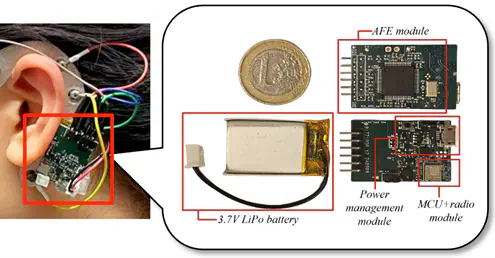Synchronized EEG with two galvanically-separated miniature wireless behind-the-ear EEG sensors

Abstract
We present a wireless EEG sensor network consisting of two miniature, wireless, behind-the-ear sensor nodes with a size of 2 cm × 3 cm, each containing a 4-channel EEG amplifier and a wireless radio. Each sensor operates independently, each having its own sampling clock, wireless radio, and local reference electrode, with full electrical isolation from the other. The absence of a wire between the two nodes enhances discreetness and flexibility in deployment, improves miniaturization potential, and reduces wire artifacts. A third identical node acts as a USB dongle, which receives and synchronizes the data from the two behind-the-ear nodes. The latter allows to process the 2x4 channel EEG as if all 8 channels are sampled synchronously, allowing the use of signal processing algorithms that exploit inter-channel correlations. To demonstrate this synchronized processing, we recorded auditory steady-state responses (ASSRs) at both ears and processed them with data-driven multi-channel filters to optimize the ASSR signal-to-noise ratio, demonstrating a more reliable ASSR detection compared to a single-ear setup.